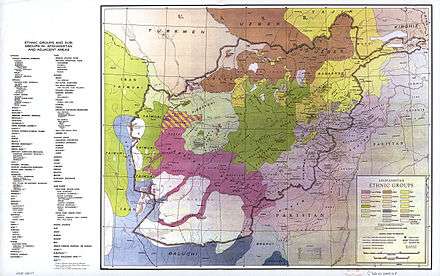Aimaq people
The Aimaq (Persian: ایماق), also transliterated as Aimak and Aymaq, are a collection of Sunni and mostly Persian-speaking nomadic and semi-nomadic tribes.[2] They live mostly found in the central and western highlands of Afghanistan, especially in Ghor, Badghis, and Herat Provinces, and to a lesser extent in the Khorasan Province of Iran.[1] Aimaqs were originally known as chahar ("four") Aymaqs: the Taymani (the main element in the population of Ghor), the Firozkohi (mostly in Badghis), the Jamshidi and the Timuri.[3] Other sources state that the Aimaq Hazara are one of the Chahar, with the Timuri instead being of the "lesser Aimaqs" or Aimaq-e digar[4] ("other Aimaqs").
| Total population | |
|---|---|
| 650,000 | |
| Languages | |
| Aimaq dialect of Dari Persian, Pashto[1] | |
| Religion | |
| Sunni Islam | |
| Related ethnic groups | |
| Hazaras, Tajiks and Pashtuns[1] |
The Aimaq speak a number of subdialects of the Aimaq dialect of Dari Persian, but some southern groups of Taymani, Firozkohi, and northeastern Timuri Aimaqs have adopted the Pashto language.[5]
Origin and culture
The Aimaqs claim to be descended from the troops of Genghis Khan.[6]
Aimaqs is a Turkic-Mongolic word that means "tribe" or "grazing territory". Aimaq Hazara and Timuri are the most Mongoloid of the Aimaqs as they live in yurts, whereas other Aimaqs live in traditional Afghan black tents.[7] The Aimaq are largely nomadic to semi-nomadic goat and sheep herders. They also trade with villages and farmers during migrations for pastures for their livestock. The material culture and foodstuffs of the Aimaq include skins, carpets, milk, dairy products and more. They tend to trade these products to settled peoples in return for vegetables, grains, fruits, nuts, and other types of foods and goods.[6]
Classification of tribes
Aimaq tribes
| Name | Tribal kind | Note |
|---|---|---|
| Aimaq Hazara | Aimaq-e digar | "Sunni subtribe of Hazara origin" |
| Chagatai | Aimaq-e digar | "Turco-Mongols of Chagatai Khanate" |
| Changezi | Aimaq-e digar | "Named after Genghis Khan" |
| Firozkohi | Chahar Aimaq | |
| Jamshidi | Chahar Aimaq | "The Jamshidi, forcibly moved from one exile to the other, became indistinguishable from Turkmen in their way of life. During this period, small groups of Aimaq Hazara and Jamshidi settled in Persian Khorasan and Turkmenistan."[1] |
| Kipchak | Aimaq-e digar | "Descendantt of Kipchaks" |
| Timuri | Chahar Aimaq | "Descendant of Timur" |
| Taymani | Chahar Aimaq | |
| Zuri | Aimaq-e digar | |
Demographics

Estimates of the Aimaq population vary between 250,000 and 500,000. They are largely Sunni Muslims--except for the Jamshidi who are mainly Ismaili Shia in the main--and in contrast to the Hazara, who are mostly Shia Muslims.[8]
See also
- Kakar
- Hazara people
- Aimaq Hazara
- Farsiwan
- Qara'unas
- Taymani
- Persian people
- Tajiks
References
- Janata, A. "AYMĀQ". In Ehsan Yarshater (ed.). Encyclopædia Iranica (Online ed.). United States: Columbia University.
- Tom Lansford -A bitter harvest: US foreign policy and Afghanistan 2003 Page 25 "The term Aimaq means "tribe" but the Aimaq people actually include several different ethnic groups. The classification has come to be used for a variety of nonaligned nomadic tribes"
- Chisholm, Hugh, ed. (1911). "Aimak". Encyclopædia Britannica. 1 (11th ed.). Cambridge University Press. p. 439.
- Willem Vogelsang (2002). The Afghans. Wiley-Blackwell. pp. 37–. ISBN 9780631198413. Retrieved 1 April 2011.
- Vogelsang, Willem (2002). The Afghans. Wiley-Blackwell. p. 18. ISBN 0631198415. Retrieved 23 January 2012.
- Winston, Robert, ed. (2004). Human: The Definitive Visual Guide. New York: Dorling Kindersley. p. 432. ISBN 0-7566-0520-2.
- http://www.tribalanalysiscenter.com/PDF-External/Hazara%20Baluchistan.pdf A SOCIOLOGICAL STUDY OF THE HAZARA TRIBE IN BALUCHISTAN (AN ANALYSIS OF SOCIO-CULTURAL CHANGE)
- "Afghanistan". Encyclopædia Britannica. Ultimate Reference Suite. Chicago: Encyclopædia Britannica, 2008.
Further reading
- Macgregor, Central Asia, (Calcutta, 1871)